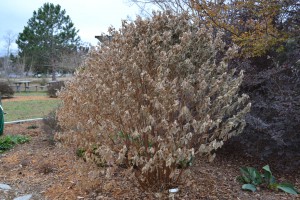
Although it is quite cold outside right now, spring is just around the corner. Many of us have perennials we enjoyed all summer and fall, and have been faced with their ugly dead stalks all winter. Perennials that are meant to die to the ground each winter look ugly and decayed after the first frost. For many perennials, the stalks have been left up and allowed to slowly die, allowing nutrients to be slowly translocated to the root system.
Many perennials, such as hibiscus species, hydrangea, salvia species, firebush (Hamelia patens), rudbeckia, echinacea, lantana and others still have a large amount of starch stored in their branches, even after the first frost. Although it was very tempting to remove these unattractive reminders of the beautiful spring gardening season, hopefully you waited to allow the starch to translocate (move) down to the root system.
Now through early March is the time to remove those unsightly dead branches to living tissue. To determine if there is “life” left in those burned and singed stems, just scratch off the top layer of the stem. If any nutrients remain in the stem, it will be green or yellow where the scratch was made. Another good way to determine if it is a good time to cut perennials back, since coastal and inland locales differ climactically, is to observe the beginning of new growth and trim at that time. If it is brown it’s dead, cut it back!
 0
0
